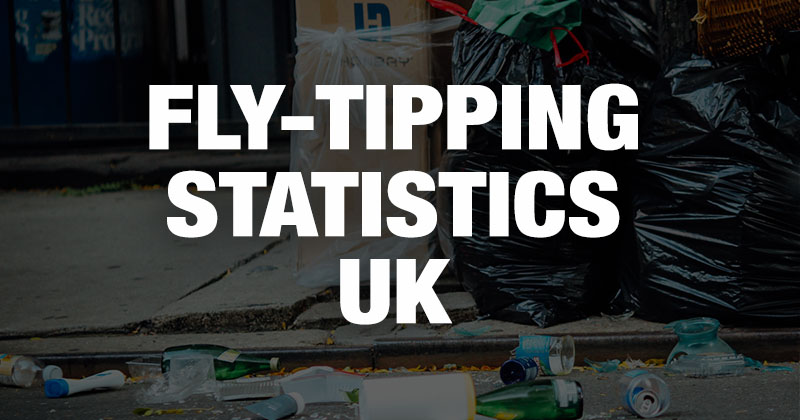Fly-tipping Statistics 2025 – How many people fly-tip in the UK?

As bleak as it may sound, when travelling around any major UK city, there's one thing you'll likely see... fly-tipping. Whether it's a fridge freezer at the side of a country lane, a bin-liner filled with rubbish lying outside a row of houses, or a rather lonely-looking car tyre at the side of the road. Fly-tipping is a problem all over the world - but just how big of an issue is it in the UK in 2025?
Oftentimes, most people aren’t aware that what they’re doing is actually fly-tipping. For instance, it can seem perfectly logical to lean your bin bag against a bin if the bin is already full – because, where else are you supposed to put it? But in fact, this is classed as fly-tipping.
So just how many people in the UK admit to having fly-tipped?
To find out, we surveyed 2,000+ UK adults in October 2023 using the market research company Censuswide, asking for more information about their habits related to fly-tipping. We also analysed third-party data on the topic.
Fly-tipping Facts & Figures in a Nutshell
In a hurry? Don’t worry - here are the key fly-tipping statistics for the UK in 2025:
- 3,157 instances of fly-tipping are reported each day in England. That’s once every 27 seconds!
- The number of fly-tipping reports in England has increased by over 20% over the last 5 years (2018 to 2024).
- In 2023-24, the cost of waste clearance in the UK was £13.1 million, a decrease of 0.75% compared to 2022-23
- The London borough, City of London and its surrounding boroughs have the highest rate of fly-tipping reports of all local authorities in England, followed by Nottingham and Liverpool.
- Household waste (Other, not black bags) is the most common fly-tipped waste type, accounting for 43% of the total incidents.
- Small van loads at 351,153 incidents are the most common size of fly-tipped waste.
How common is fly-tipping in the UK
Fly-tipping can take a wide variety of forms, from household waste dumped on rural roadsides to rubbish bags left outside overflowing bins in urban areas. Whether done intentionally or not, illegally dumped waste such as this poses significant risks to public health and the environment, as well as detracting from an area’s appeal. So just how prevalent is fly-tipping in the UK?
To find out, we used Censuswide to ask a demographically representative sample of 2,009 UK adults:
As you can see from the graph:
- Almost 8% of people in the UK (1 in every 13) can say they frequently leave a black bin bag or other waste outside next to an already-full bin.
- 11% (1 in 10) say they fly-tip in this way regularly, and 14% say they sometimes do so.
- 17% say they have done this, but rarely.
- Whilst around half of Brits say they’ve never fly-tipped in this way.
So, it’s clear that a significant proportion of people in 2023 fly-tipped at some point - even if it was unintentional! But how about the prevalence of all types of fly-tipping in the UK? How often are instances of fly-tipping reported?
Fly-tipping rates in the UK over time
To discover how frequently instances of fly-tipping are reported and understand the trends in fly-tipping rates over time, we delved into government data on fly-tipping incident reports in England, which found:
- In the year ending 2024, there were over 1.1 million reports of fly-tipping incidents in England (1,152,617).
- That means 3,157 instances of fly-tipping are reported each day in England. That’s an average of once every 27 seconds!
- Additionally, the number of fly-tipping reports in England has increased by over 20% over the last 5 years (2018 to 2024).
- This has now surpassed the dataset between 2020-2021, which previously saw the highest number of incidents when over 1,138,347 reports of fly-tipping were filed. An increase of 14,270 incidents.
Please note: All government datasets are collected from April to March in any given year.
- Between April 2023 and March 2024, in Wales, 42,171 instances of fly-tipping were reported, which is an increase of 6% from the previous year
- Whilst in Scotland, it is estimated there were 66,159 reports of fly-tipping in 2023, creating 26,739 tons of fly-tipped waste.
Are men or women more likely to fly-tip?
So now we know how common fly-tipping is on a whole across the country. But who’s most likely to dispose of their waste in this way? Men or women?
- Whilst the numbers are close, the results of this survey found that men are slightly more likely than women to fly-tip by leaving waste next to already-full outdoor bins.
- When it comes to frequency, our survey found that twice as many men as women engage in this behaviour on a frequent basis (10% of men vs 5% of women).
Household waste management and age: Which generation fly-tips the most?
As the findings in the above section revealed, men are significantly more likely than women to fly-tip their household general waste on a regular basis (even if this may be accidental). But how do our household waste management habits change as we age?
To find out, we grouped our respondents into age categories and compared their answers, which found:
- Gen Z-ers appear to be amongst the biggest fly-tippers in the UK, with 81% of respondents aged 18-24 admitting to leaving their waste in bin liners next to full bins in the street.
- However, if we look at millennial age groups, this figure drops significantly, with 60.76% of 25-34 year olds and 61.38% of 35-44 year olds saying they’ve done the same.
- This number drops even lower if we look at baby boomers. With only around 47% of 45-54 year olds and 32% of those age 55 and over saying they’ve ever done this.
So why is this? Do we just become older and wiser with our waste as we age? Or are there other factors at play?
- A study conducted by DS Smith in 2022 found that Gen Zs were less confident about which items they could and couldn’t recycle compared with older generations.
- Their study found that only 66% of Gen Z-ers were confident about what types of packaging can be recycled, compared to 81% of people aged 55 and over.
Fly-tipping by city: Which parts of the UK have the most instances of fly-tipping?
Now that we've looked at the age groups that statistically appear to fly-tip the most, we wanted to identify which cities in the UK have the highest rate of fly-tipping occurrences.
To do so, we analysed the Department for Environment, Food & Rural Affairs (DEFRA)’s most recent report, weighting this by the latest population figures for each local authority, which revealed that:
- The City of London has the highest rate of fly-tipping reports of all local authorities in England, with 172 instances being reported per 1,000 of the population.
- Croydon, Camden, Hackney, and Lewisham all made the top 5 of Total Incidents recorded.
- 15 of the top 20 local authorities with the highest proportion of fly-tipping reports per 10,000 people are London Boroughs, and increase of 3 from 2023.
Top 20 Local Authorities with the Highest Rates of Fly-tipping in England
| Rank | Local authority | Fly-tipping incidents per 1,000 people |
|---|---|---|
| 1. | City of London | 172 |
| 2. | Camden | 157 |
| 3. | Hackney | 127 |
| 4. | Westminster | 121 |
| 5. | Nottingham | 93 |
| 6. | Lewisham | 92 |
| 7. | Hounslow | 92 |
| 8. | Croydon | 90 |
| 9. | Brent | 78 |
| 10. | Boston | 77 |
| 11. | Merton | 75 |
| 12. | Southwark | 73 |
| 13. | Hammersmith and Fulham | 64 |
| 14. | Haringey | 63 |
| 15. | Newham | 54 |
| 16. | Newcastle-upon-Tyne | 51 |
| 17. | Redcar and Cleveland | 51 |
| 18. | Kensington and Chelsea | 49 |
| 19. | Pendle | 48 |
| 20. | Harrow | 48 |
Our survey’s findings also corroborated this, with the results revealing that:
- 63% of Londoners say they’ve left their rubbish bags next to an already-full, outdoor bin – the highest of all UK cities.
- This was closely followed by Plymouth (57%), Cardiff (56.76%) and Nottingham (53.4%).
Which cities have the fewest fly-tipping reports?
Our analysis also revealed which parts of the country have the lowest rates of fly-tipping. As you can see from the table below:
- Again, in the year ending 2024, as there were in 2022 and 2024, there were zero reports of fly-tipping on the Isle of Scilly, making it the least problematic part of the country when it comes to the issue.
- Following closely behind were Oadby and Wigston, Rutland, Malvern Hills and Amber Valley.
Top 10 Local Authorities with the Lowest Rates of Fly-tipping in England
| Rank | Local authority | Incidents per 1,000 people |
|---|---|---|
| 1. | Isles of Scilly | 0 |
| 2. | Oadby and Wigston | 0.2 |
| 3. | West Suffolk | 1.4 |
| 4. | Amber Valley | 1.7 |
| 5. | East Devon | 2.1 |
| 6. | Erewash | 2.1 |
| 7. | Fareham | 2.2 |
| 8. | Malvern Hills | 2.7 |
| 9. | North Lincolnshire | 2.9 |
| 10. | Rutland | 3 |
Whilst our survey found that people in Liverpool, Edinburgh, Norwich and Newcastle are the least likely to admit to leaving bin liners of rubbish next to already-full outdoor bins - which is a little-known form of fly-tipping.
More Fly-tipping Facts and Figures
To demonstrate the impact that fly-tipping has on the UK, we’ve pulled through some enlightening statistics from other trusted sources.
How much does fly-tipping cost the UK economy?
The government’s most recent Fly-tipping report revealed that:
- In 2023-24, the cost of clearing large-scale fly-tipping incidents in England was £13.1 million.
- That was an increase of over 20% compared to 2019-20's £10.9 million.
It’s worth noting that these figures only take into account significant fly-tipping incidents, such as tipper lorry loads being dumped, and don't factor smaller scale cases of fly-tipping.
Where do most fly-tipping incidents occur?
The government's most recent report also revealed that in 2023-24:
- 38% fly-tipping incidents took place on the highway.
- 30% involved small van loads of waste.
- 27% of incidents involved waste that could fit into a standard car’s boot.
Fly-tipping and waste statistics of 2025
We hope this piece has helped provide you with a comprehensive overview of fly-tipping in the UK in 2025. If you’re struggling to find suitable waste management options for your household or business, we’re here to help. We have a range of services available, from skip hire to man with van rubbish removals and our very own HIPPOBAGs.
Methodology
Our survey was conducted using the market research company, Censuswide, on 05/10/2023 and surveyed a representative sample of 2,009 UK adults. If you’d like access to the raw survey data, please email web.enquiries@hippowaste.co.uk

